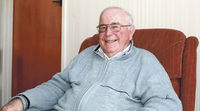A youth movement that attracted some 1400 members in the 1950s and 1960s, a national association of priests comprising half of all the country’s priests in the 1970s and an ongoing scholarship that led him to attempt to challenge his congregations out of mediocrity are achievements for which John Broadbent might be remembered although these are not his most important.
Msgr John Broadbent has been retired for the past five years but, at 80, he still writes and delivers lectures on church history, his great passion, and gives retreats.
The youth club which became known as the Capistrano Club for young people in the Hutt Valley in the 1960s was a partial response to the Report of the Special Committee on Moral Delinquency in Children and Adolescents 1954 known as the Mazengarb report.
 ‘Basically I realised that the Catholic Youth Movement, of which I was a chaplain, comprised the kids from good families but there was a huge number of young people that weren’t being touched by the Catholic school they went to or by the Catholic church much. An atmosphere was needed in which these young people could be contacted and listened to.’
‘Basically I realised that the Catholic Youth Movement, of which I was a chaplain, comprised the kids from good families but there was a huge number of young people that weren’t being touched by the Catholic school they went to or by the Catholic church much. An atmosphere was needed in which these young people could be contacted and listened to.’
So the club offered a cinema, coffee bar, table tennis, billiards ‘and most of all there was dancing. We got some wonderful youth bands and they changed every 20 minutes. The kids loved it’.
‘I realised that the church is really a collectivity and to get the kids used to it, they had to learn to run things themselves.’
His first seven years as a priest were spent in the busy Lower Hutt parish of Ss Peter and Paul.
Another highlight of Msgr Broadbent’s life came from a year travelling through Asia and India in 1964 and staying in basic accommodation. Arriving in Europe he ‘utterly fell in love with Spain. It was under Franco and there was a lot of poverty but the Spaniards were wonderful people and I stayed much longer than I intended.’
Then, because he had tried the monastic life, he was allowed to live as a hermit for a year in a hut at the back of Mangakino. ‘It was marvellous. I got really close to God. Then I realised that I was only escaping. It helped me to accept the pastoral vocation completely and find God in my work and in the people I worked with.’
After a stint as parish priest in Johnsonville and Nelson, he was granted a Todd Foundation scholarship to study church history at Louvain in Belgium and then taught church history for seven years at the Pacific Regional Seminary in Fiji. In 1983 he returned to Wellington to build a university chaplaincy with then Sr Katherine Egan, Sr Leona Garshow, Gerald Scanlan and John Dalgety. With the help of a generous donation, the team bought the present Kohanga on Kelburn Parade.
Somehow Msgr Broadbent found time to publish a book which he called Restoring the Laity’s Balance to an Unsteady Church 1999. ‘It’s looking historically at the early church and how it gradually became a more clerical church controlled by the papacy and the curia.’
Everything happens in context, he says, and history provides the real context of how it happened and unfortunately afterwards it’s often mythologised or deemed unchangeable. Here, he says, we are not speaking of infallible doctrines but in the minds of many as doctrines bordering on infallibility.
‘The church historians are very valuable because they put things in the context of how they happened and, where events have been mythologised, historians can now, as Vatican II did, begin to unravel things that need to be changed. It is important to keep a balance.’
This means consulting the laity before making decisions as was more transparent in the first centuries of the church. ‘The laity don’t make the final decisions. That’s part of being Catholic. But the hierarchy have the authority to make those decisions and in the non-infallible area they can be changed.
‘As has been pointed out recently at international synods, New Zealand’s bishops have courageously asked for more discussion on communion for remarrieds. This can apply, too, for permission for married priests and the status of women in the church’s governance.’
‘These things probably won’t change in my lifetime,’ says Msgr Broadbent ‘but changes could happen in the next decades.’
Schooling:
St Joseph’s, Nelson
St Patrick’s, Silverstream, as a boarder
Work record:
At 17, joined the Benedictines in England for four and a half years which gave him a love of prayer
Worked six months in Melbourne
Holy Cross seminary, Mosgiel—ordained after 18 months.
Ss Peter and Paul, Lower Hutt – seven years
St Joseph’s, Waitara – one year then one year’s sabbatical
St Patrick’s, Palmerston North – two years
Ss Peter and Paul, Lower Hutt – one year as administrator
Sacred Heart, Takaka – one year then one year in a hermitage
Ss Peter and Paul, Johnsonville – three years
St Mary’s, Nelson – 18 months
Louvain, Belgium – two years
Pacific Regional Seminary, and University of the South Pacific Suva, Fiji
– seven years
Tertiary chaplaincy – three years
Bishops’ Conference secretary – two years
Holy Cross College, Mosgiel – six years, four as rector
Pacific Theological College (Protestant), Suva, two and a half years
Ss Peter and Paul, Lower Hutt briefly
St Mary’s, Nelson – one and a half years
Our Lady of the Rosary, Waiwhetu – two years
Retirement – lectures, retreats and supplies.